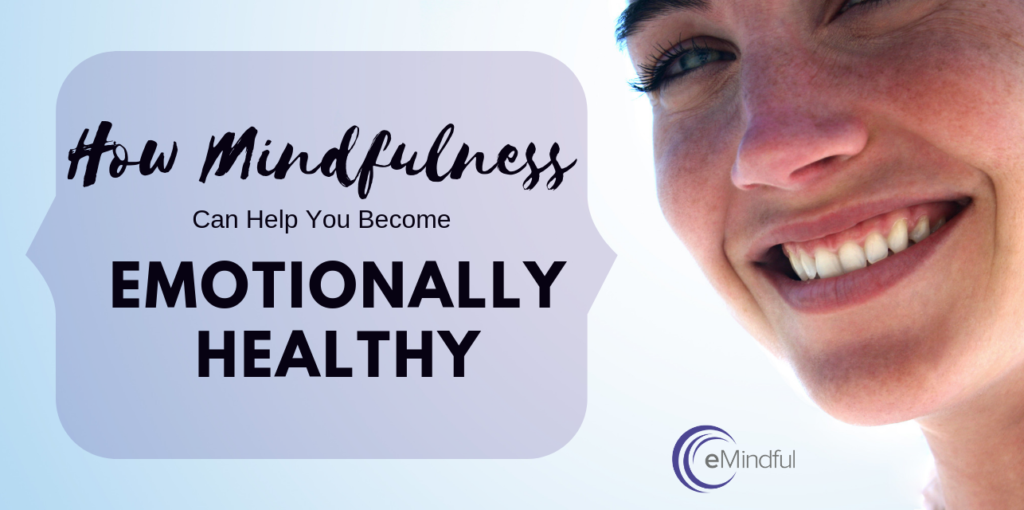
June 12, 2019
How Mindfulness Can Help You Become Emotionally Healthy
Not long ago I was driving with a friend in rush hour traffic. As she merged onto a crowded freeway onramp she sighed and, with irritation in her voice, said: “I think we’re going to hit some bad traffic and I think I’m going to have to manage my feelings about it.”
We both laughed at her outburst of honesty. But as we settled in for our bumper-to-bumper drive, I thought about how wise my friend was.
She was obviously peeved. Mostly, though, she was aware of her unpleasant feelings. She also understood that she had a choice whether to let them completely sour her mood or to find an appropriate way to be with them. She chose to enjoy her extra time with me and made a mental note to herself: “Don’t drive in crosstown traffic at 5:30 p.m. on a Friday.”
It isn’t always easy to find such a healthy approach toward our feelings. Emotions are powerful and mysterious forces that can unexpectedly rise to the surface or lay dormant for years. Sometimes we wind up expressing our feelings before we’re aware of them. At other times, emotions such as anger or grief get suppressed and remain unexpressed for even decades.

Emotional Health: The Power of Emotions
Emotions, especially difficult ones, are powerful for a reason. From an evolutionary standpoint, they act as an elegant internal guidance system, telling us when to pay attention to danger and signaling to us when things are safe. Fear, for example, helped our ancestors survive saber-tooth tiger attacks.
When we’re emotionally healthy, we can use our emotional guidance system to help us better understand our circumstances and ourselves and take productive action so we can flourish. Rather than a steady state to be achieved, emotional health is a moment-to-moment process of awareness, acceptance and responsiveness. When we’re emotionally healthy we’re willing to acknowledge our emotions, feel them and respond rather than react.
It’s not always easy. But just as we can become physically healthy by making more of an effort to eat nutritiously and exercise more, we can become emotionally healthy as well. There are many ways to become emotionally healthy, whether seeing a therapist or reading books on the topic. Another significant tool in fostering emotional health is mindfulness.
How Mindfulness Makes us Emotionally Aware
Mindfulness is the awareness that arises when we pay attention to the present moment with curiosity, openness and non-judgment. Being mindful also entails willingness to stay with whatever is arising in any given moment long enough so that we can respond to it with wisdom and kindness.
Whether she knew it or not, my friend was using a mindful approach to her rush- hour irritation by naming her feeling, fully connecting to it and then relating to it in a wise way.
Being emotionally healthy doesn’t mean we’re always happy or that we don’t experience difficult feelings. It also doesn’t mean that we don’t express our feelings at times in ways we wish we hadn’t. No one is perfect. Being emotionally healthy, however, allows us to keep our fleeting feelings in perspective, be compassionate with ourselves when difficult feelings arise and find equilibrium again once an emotional thunderstorm has passed.

Use the RAIN Method for Emotional Well-being
One mindfulness practice that can help us cultivate emotional wellbeing is RAIN. The acronym stands for: Recognize, Allow, Investigate and Non-Identify. Below is a short description of the practice:
1. Recognize
One of the first steps in becoming more aware of what you’re feeling is to label the feeling as it’s arising. By silently naming an emotion to yourself – “fear, fear, fear,” for example – you can help quell your sense of overwhelm.
2. Allow
We might not always like what we’re feeling. But from the perspective of mindfulness whatever we’re feeling is okay.
What we do with our feelings is another matter. But by allowing our emotions to move through us more freely we lessen their hold over us and can begin to understand them better.
3. Investigate
Once we’ve named and allowed an emotion to be present we can get to know it a bit better. How does anger feel in your body? What thoughts are connected to the feelings of anger? By investigating our emotions we can learn to relate to them with greater wisdom and kindness.
4. Non-Identify
Often, after going through the above steps you might notice that you have more space around whatever you’re feeling and that you’re less reactive. Doing so allows us to non-identify with our emotions and not take them so personally.
Being emotionally healthy takes effort, but doing so is often the difference between living with more ease and being unduly stressed. Practice RAIN any time an emotion arises. Over time, you’ll likely find that you’re able to navigate your feelings more easily and even learn from them.
Increase Emotional Awareness with eMindful’s Mindful Dailies
eMindful offers live 14-minute (that’s just one percent of your day!) mindfulness sessions every day, multiple times a day. Develop and strengthen skills like stress management, compassion, forgiveness, anxiety and more. Login or create your free account now to catch an upcoming session with teachers like Kelly.
About the Author
Kelly Barron. M.A., is a certified mindfulness facilitator, at UCLA and writer. She teaches mindfulness for UCLA’s Mindfulness Research Center as well as for corporations, schools and private groups. Kelly has worked as a mindfulness teacher with eM Life since 2016. She came to learn the value of mindfulness as a deadline-driven journalist. Now, she’s passionate about sharing mindfulness with others to help them live with more ease, clarity and joy. You can learn more about Kelly and read her blog at www.kellybarron.com.